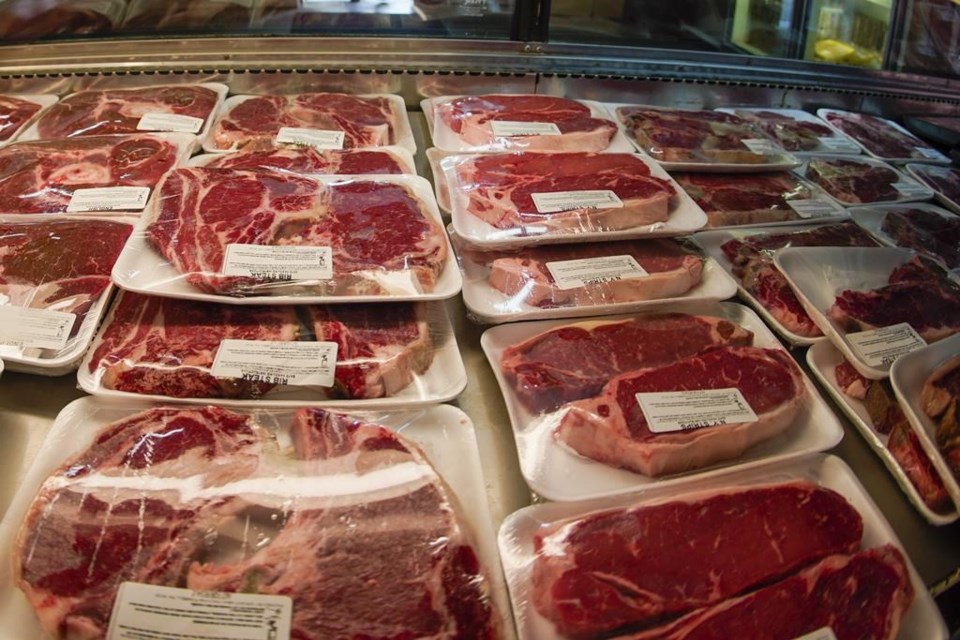Shoppers could soon find it easier to tell if those grocery store steaks or pork chops were really “Made in the USA.”
Federal agriculture officials on Monday released new requirements that would allow labels on meat, poultry or eggs to use that phrase -- or “Product of USA” -- only if they come from animals “born, raised, slaughtered and processed in the United States.” That’s a sharp change from current policy, which allows voluntary use of such labels on products from animals that have been imported from a foreign country and slaughtered in the U.S., but also on meat that's been imported and repackaged or further processed.
Imports of beef from countries including Australia, Canada and Brazil, for instance, account for about 12% of the total consumed in the U.S. Overall, imports of red meat and poultry account for less than 6%, while imports of eggs account for less than half of 1%.
U.S. Department of Agriculture Secretary Tom Vilsack said the proposed rule would better align the labels with consumers’ views. A survey commissioned by the USDA found that nearly two-thirds of shoppers believed that a “Product of USA” label meant that most or all meat production steps occurred in the U.S.
“There’s obviously a disconnect between what the consumers’ understandings and expectations are and what the label currently is,” Vilsack said in an interview.
About 12% of all meat, poultry and egg products sold in the country carry the U.S.-origin labels, USDA officials said.
The label change was first proposed by President Joe Biden in 2021 and was included last year in a series of steps to bolster the U.S. meat and poultry supply chain.
The USDA survey, conducted last summer, included a nationally representative sample of more than 4,800 American adults who do the grocery shopping for their families and who bought beef or pork in the previous six months. More than 40% of the shoppers said they look for the USA label when buying meat.
The rule was praised by consumer advocates and representatives for U.S. ranchers and farmers, including the U.S. Cattlemen's Association, which petitioned the USDA for the label change in 2019.
“The proposed rule finally closes this loophole by accurately defining what these voluntary origin claims mean,” said Justin Tupper, the group's president. "If it says ‘Made in the USA,’ then it should be from cattle that have only known USA soil. Consumers have the right to know where their food comes from, full stop.”
Thomas Gremillion, director of food policy for the Consumer Federation of America, said the change is a “small but important step” that should have been made long ago.
Under the current rule, Gremillion noted, a cow can be raised in Mexico under that country's regulations for feed and medications, then shipped across the border and slaughtered that same day to make ground beef and steaks that qualify as “Product of USA.”
Carrie Balkcom, executive director of the trade group American Grassfed Association, said the existing rule also penalizes small domestic producers.
“It’s expensive to raise grass-raised animals from scratch,” Balkcom said. “And these large producers were importing these animals raised elsewhere and just repackaging them and then kind of coasting on the ‘Made in the USA’ label."
An official with the North American Meat Institute, which represents large firms that process most of the meat and poultry products sold in the U.S., said she hadn’t seen details of the new rule. But Sarah Little added, the group “opposes overly prescriptive labeling requirements that will raise prices for consumers.”
Another industry group, the National Cattlemen’s Beef Association, has called for eliminating the voluntary USA labels entirely and allowing for strict labeling standards verified by the USDA.
The voluntary labeling rules are different from country-of-origin labels, known as COOL, which required companies to disclose where animals supplying beef and pork are born, raised and slaughtered. That requirement was rolled back in 2015, after international trade disputes and a ruling from the World Trade Organization.
Country-of-origin labels are still required for other foods, including fish, shellfish, fresh and frozen fruits and vegetables and more.
Companies won’t have to prove that their products are American-made before using the labels, but they will have to file documentation. The proposal applies only to meat, poultry and eggs, products overseen by the USDA's Food Safety and Inspection Service, which can pull the label if companies are found to violate the rule.
The label proposal is open for public comment before it becomes final.
—-
The Associated Press Health and Science Department receives support from the Howard Hughes Medical Institute’s Science and Educational Media Group. The AP is solely responsible for all content.
Jonel Aleccia, The Associated Press



